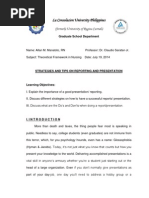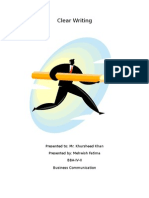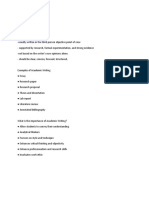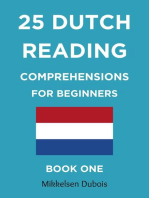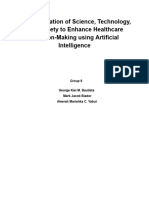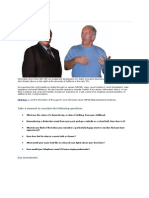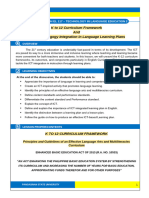Chapter 3 Summary 1
Uploaded by
api-515409227Chapter 3 Summary 1
Uploaded by
api-515409227To: Nancy Myers
From: Sarah Hauge
Date: April 14, 2020
Subject: APLED 121-Chapter 3 Summary
CHAPTER 3
OBJECTIVES IN TECHNICAL COMMUNICATION
Achieving Clarity in Technical Communication - Problems can occur if you write something
that is unclear for your reader.
● Provide Specific Detail
○ Don’t use words like “some” or “recently”
○ Express yourself clearly
● Answer the Reporter’s Questions - Who, What, When, Where, Why
● Use Easily Understandable Words
○ Careful with acronyms or jargon.
Simplifying Words, Sentences and Paragraphs for Conciseness - Why use many word
when little word do trick?
● Conciseness Saves Time
○ Don’t waste people’s time.
● Technology Demands Conciseness
○ Be aware of character limitations or specific dimensions.
○ Don’t make someone search for the meat.
● Conciseness Improves Readability
○ “Readability” is the level you’re writing at, based on word and sentence lengths.
(5th grade, 9th grade, college, etc)
○ Many people read at the lowest levels - remember you are communicating with
the general public, not showing off.
○ Many readers prefer to skim rather than reading in depth.
● Limit Word Length for Conciseness
○ Try to use words under two syllables, but if you need to use a long word - use it!
○ Don’t use old-fashioned words or legalese.
● Limit Sentence Length for Conciseness
○ 12 words or less is easy to read. 15-20 is Plain English. Over 20 is cumbersome.
○ Use active language.
■ Concluded, instead of “came to the conclusion”
■ Let’s meet, not “We should have a meeting”
○ Turn long sentences into multiple sentences.
● Limit Paragraph Length for Conciseness
○ Good length is four to six typed lines.
○ Break up the information to more open, easy to view formatted sections.
Achieving Accuracy in Technical Communication - The writer’s credibility will be suspect if
errors are found.
● Proofreading Tips
○ Let someone else read it - you know what you wrote, but they will find issues.
○ Read it again after a break, and read it out loud.
○ Printed words are easier to correct.
○ Don’t forget your computer has a spelling and grammar check.
Organizing Technical Communication - Even without errors, it’s hard to follow someone’s
rambling thoughts or make sense of a wall of text. Ways to organize:
● Spatial organization, Chronology, Importance, Comparison/Contrast, Problem/Solution,
Cause and Effect.
The Writing Process at Work
● Prewriting - Capture your thoughts in outline format, using abbreviations for brevity.
● Writing - Write your document.
● Rewriting - Use the proofreading tips and think about how your reader will receive your
information.
You might also like
- W1 - Slide 1 - Introduction To Presentation SkillsNo ratings yetW1 - Slide 1 - Introduction To Presentation Skills43 pages
- Engligh Assignment On Writing Skills: Deewakar Golyan A2315809030 B.Tech-CivilNo ratings yetEngligh Assignment On Writing Skills: Deewakar Golyan A2315809030 B.Tech-Civil12 pages
- Grade 10 12 English Guideline For Teaching and Writing Essays and Transactional Texts PDFNo ratings yetGrade 10 12 English Guideline For Teaching and Writing Essays and Transactional Texts PDF46 pages
- Unit 3 - MATCHING STYLE AND CONTENT TO THE AUDIENCENo ratings yetUnit 3 - MATCHING STYLE AND CONTENT TO THE AUDIENCE5 pages
- Muni University: Chapter 1:professional CommunicationNo ratings yetMuni University: Chapter 1:professional Communication74 pages
- Clear Writing: Presented To: Mr. Khursheed Khan Presented By: Mehwish Fatima Bba-Iv-Ii Business Communication100% (1)Clear Writing: Presented To: Mr. Khursheed Khan Presented By: Mehwish Fatima Bba-Iv-Ii Business Communication8 pages
- Objective of Lesson: Summarizing Summary Writing100% (1)Objective of Lesson: Summarizing Summary Writing19 pages
- 25 Dutch Reading Comprehensions for Beginners: Book One: Dutch Reading Comprehension TextsFrom Everand25 Dutch Reading Comprehensions for Beginners: Book One: Dutch Reading Comprehension TextsNo ratings yet
- Introduction To Human Resource Management Course OutlineNo ratings yetIntroduction To Human Resource Management Course Outline6 pages
- Introduction To Philosophical Perspectives of The Self (Includes Socrates & Plato)No ratings yetIntroduction To Philosophical Perspectives of The Self (Includes Socrates & Plato)29 pages
- PDF Personality, Individual Differences and Intelligence 5th Edition John Maltby download100% (4)PDF Personality, Individual Differences and Intelligence 5th Edition John Maltby download66 pages
- Class XI Summer Assignment 2022-23 JULY FINALNo ratings yetClass XI Summer Assignment 2022-23 JULY FINAL9 pages
- Music Source Separation: Francisco Javier Cifuentes Garc IaNo ratings yetMusic Source Separation: Francisco Javier Cifuentes Garc Ia7 pages
- Pengembangan Media Powtoon Berbasis Audiovisual Pada Pembelajaran SejarahNo ratings yetPengembangan Media Powtoon Berbasis Audiovisual Pada Pembelajaran Sejarah11 pages
- Tve1 Module 4 Introduction To AndragogyNo ratings yetTve1 Module 4 Introduction To Andragogy40 pages
- Eye Accessing Cues: Take A Moment To Consider The Following Questions100% (1)Eye Accessing Cues: Take A Moment To Consider The Following Questions6 pages
- Alexander (1937) - Remarks About The Relation of Inferiority Feelings To Guilt FeelingsNo ratings yetAlexander (1937) - Remarks About The Relation of Inferiority Feelings To Guilt Feelings9 pages
- Ai Cybersecurity Intelligent Systems Reference Library100% (7)Ai Cybersecurity Intelligent Systems Reference Library215 pages































